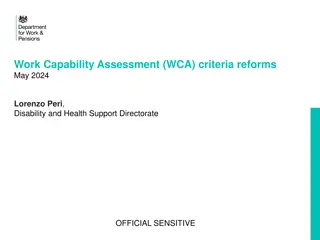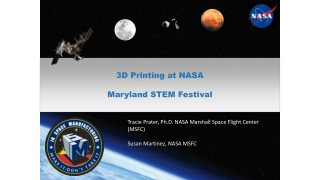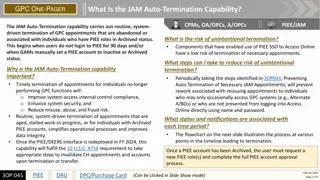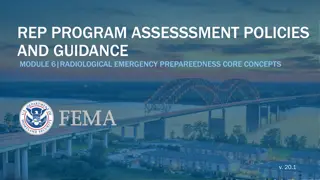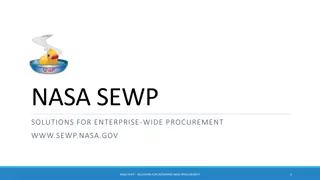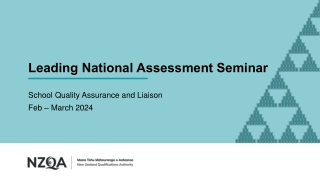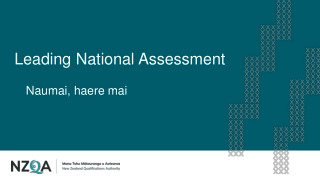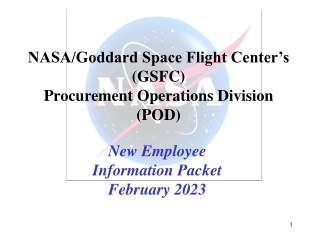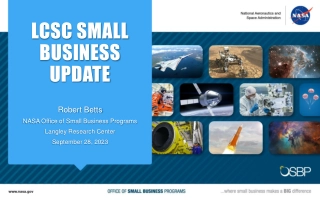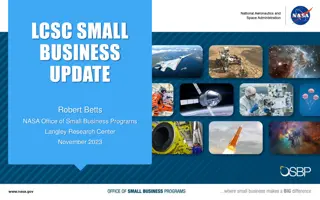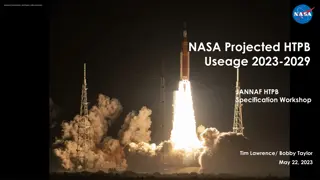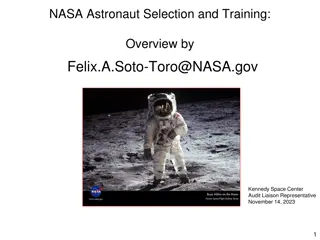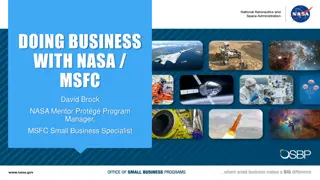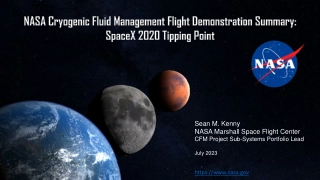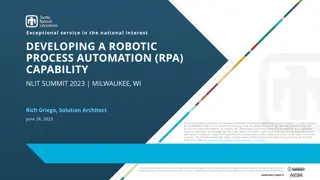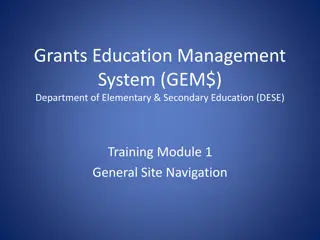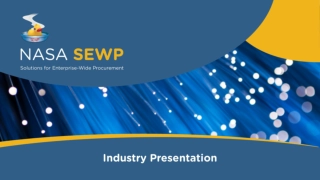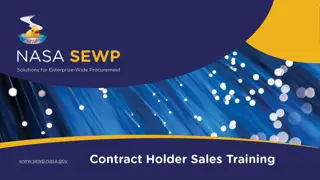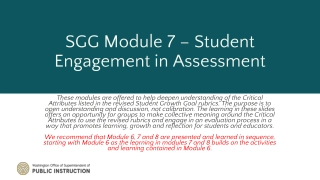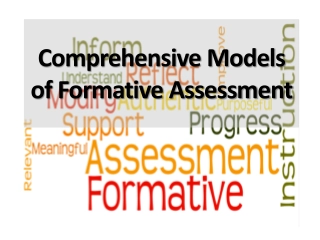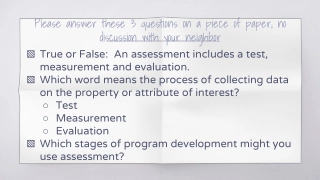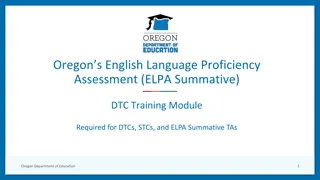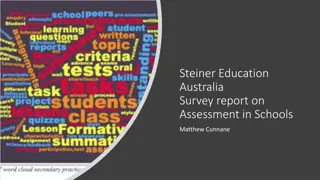NASA Navigation Sensor Technology Assessment Capability
The assessment of navigation sensor technologies for data-driven systems analysis by NASA in October 2023. Discover the motivation, method, survey, simulation model, and selected results of this capability.
Download Presentation
Please find below an Image/Link to download the presentation.
The content on the website is provided AS IS for your information and personal use only. It may not be sold, licensed, or shared on other websites without obtaining consent from the author. Download presentation by click this link. If you encounter any issues during the download, it is possible that the publisher has removed the file from their server.
- NASA
- navigation sensor technology
- assessment capability
- data-driven systems analysis
- mission success
- technology survey
- simulation model
- critical parameters.
Presentation Transcript
National Aeronautics and Space Administration Navigation Sensor Technology Assessment Capability for Data-Driven Systems Analysis October 2023 Esther Lee, Paul V. Tartabini, Brett R. Starr, Paul D. Friz, Christopher D. Karlgaard, and Jamshid Samareh NASA Langley Research Center www.nasa.gov
Outline Motivation Method Technology Survey Simulation Model Overview Approach Selected Results Key Takeaways Future Work 2
Motivation NASA is planning missions to land crew and cargo on the Moon (and later, Mars) More innovative navigation technologies will be available to benefit these landers How to assess each technology s impact on mission success? 3 3
Motivation (Contd) This technology assessment capability was developed and is refined to perform system-level assessment for innovative technologies Identify trends, technology critical parameters, and potential improvements for selected technologies Data-driven results to quantify technological impact to: Facilitate stakeholders decision-making Inform/guide research developments to decide critical parameters for improvements 4
Method Evaluate sensors from an integrated performance perspective and their impact on the overall system performance Perform technology survey for existing and emerging advanced navigation technologies Leverage existing six degree-of-freedom, physics-based engineering simulation for government reference lunar lander as testbed Caveat & Assumption: Results are dependent on vehicle configuration and mission No alterations to guidance software, focus is on technology hardware assessment Technology Parameters from Technology Survey Lunar Lander Simulation Technology Assessment Quantifiable Results w.r.t. Mission Success 5
Technology Survey Advanced navigation sensors surveyed in this study: 1. Inertial Measurement Unit (IMU) 2. Navigation Doppler Lidar (NDL) 3. Radar Altimeter 4. Radar Velocimeter 5. Terrain Relative Navigation (TRN) Critical parameters for these sensors were gathered by collecting publicly available data from online sources 1. IMUs 2. NDL 3. Radar Altimeter 5. TRN 4. Radar Velocimeter Source: Position Navigation Timing Survey Results Final Report- 2021-08-27-HLS-Approved.pptx Trade names and trademarks are used in this report for identification only. Their usage does not constitute an official endorsement, either expressed or implied, by the National Aeronautics and Space Administration. 6
Lunar Lander Simulation Overview Six degree-of-freedom, physics-based engineering simulation used as technology assessment testbed Vehicle configuration: Government reference mini-DAC (Design Analysis Cycle) Two elements: Descent Element and Ascent Element Three Main Engines and 16 Reaction Control Systems Navigation sensor suite: IMU, Star Tracker, DSN, TRN, and NDL Source: Lugo et al., Precision Landing Performance and Technology Assessments of a Human-Scale Lunar Lander Using a Generalized Simulation Framework, AIAA 2022-0609. DOI = De-Orbit Initiation PDI = Power Descent Initiation DSN = Deep Space Network 7
Approach Perform Technology Survey Technology parameters are modeled in the lunar lander simulation framework Multiple series of 8,000 runs Monte Carlo simulations were performed Evaluated against performance metrics defined for landing success All requirements must be met: 1. Landing precision: range to the target at touchdown is 100 m or less. 2. Horizontal velocity at touchdown is less than 1 m/s. 3. Vehicle angle is less than 3 degrees off vertical at touchdown. 4. Maximum vehicle angular rates about all axes are less than 0.5 deg/s. Run 6DOF Simulation Perform Technology Assessment Evaluate Against Performance Metrics 8 Success metrics
Capability Demonstration: Successful Landing Sensitivity to IMU Bias Monte Carlo studies showed that the IMU Accelerometer X-axis Bias was the most sensitive parameter that influenced mission failure rate Low-Quality IMU Failure Rate Evaluated three IMU quality-levels for landing performance The Low-Quality IMU performance could be improved by reducing only the Accelerometer X-Bias Medium-Quality IMU Failure Rate High-Quality IMU Failure Rate Impact: identified critical parameter and indicate where further improvements would be most beneficial *Results only valid for mini-DAC government reference vehicle with SPLICE sensors suite. 9
Capability Demonstration: Evaluated Low Technology Readiness Level (TRL) Technology Scaled parameters of an existing high quality, high TRL IMU are used to represent the Low TRL IMU (i.e., Quantum Positioning System) parameters Monte Carlo studies showed that number of failed landings are reduced when high quality, high TRL IMU errors were reduced. Reducing the error by more than does not improve landing accuracy Impact: identified improvement threshold with diminishing return 10
Capability Ongoing Development: Evaluating Radar Altimeter-Velocimeter combination Evaluated altimeter-velocimeter performance relative to Gen-3 NDL Set altimeter-velocimeter measurement precision to be equivalent to 10X, 25X, 50X, and 100X less precise than Gen-3 NDL Results indicate landing success degrading nearly linearly as altimeter-velocimeter measurement precision decreases more than 10X Low fidelity sensor models may be overpredicting performance Models do not include parameters such as pointing or attitude knowledge errors that affect measurement accuracy *Results only valid for mini-DAC government reference vehicle with SPLICE sensors suite. Impact: trends revealed threshold to ensure landing success 11
Key Takeaways An overview of navigation sensor technology assessment capability approach applied to lunar landing mission and evaluated against landing success criteria Quantitative results were shown Influential parameter for sensor type Diminishing returns for reducing sensor errors Broader impact of capability Similar method can be applied to a Mars or other surface landing vehicle Perform risk assessments Apply the method to other disciplines 12
Future Work Implement other sensor models into the simulation Upgrade Navigation Doppler Lidar model Explore Terrain Relative Navigation model impact Apply rapid assessment capability with trajectory reconstruction tool NewSTEP to enhance Monte Carlo approach Linear covariance analysis enables rapid trade studies as it does not require Monte Carlo techniques for uncertainty assessment 13
Thank you 14
National Aeronautics and Space Administration BACK UP 15 www.nasa.gov
Rapid Assessment Capability: NewSTEP The Monte Carlo approach of assessing sensor performance can be costly in terms of the time needed to run thousands of high fidelity 6-DOF simulations New Statistical Trajectory Estimation Program (NewSTEP) is a Kalman filter code specifically formulated for solving trajectory reconstruction problems NewSTEP can be configured to emulate navigation system performance and can produce uncertainty estimates from linear covariance analysis. Linear covariance analysis enables rapid trade studies as it does not require Monte Carlo techniques for uncertainty assessment. The rapid assessment capability can be used to explore sensor capabilities or other navigation filter assumptions Filter tuning parameters However, NewSTEP s linear covariance analysis mode does not capture dispersions as it uses a nominal trajectory to propagate uncertainty estimates Complements Monte Carlo approach in technology assessment 16



